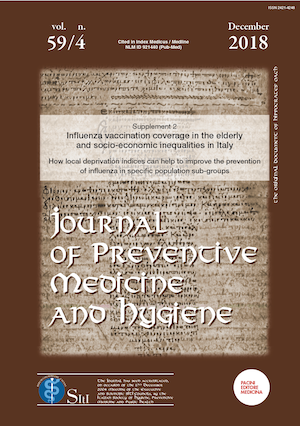Abstract
Introduction. A socio-economic (SE) deprivation index is a measure which aim is to provide an indication of a SE condition of hardship and disadvantage in the population. This study provided ten Socio-Economic and Health Deprivation Indices (SEHDI) calculated with a shared methodology. The peculiar construction method makes them suitable for investigating the relationships between SE inequalities and aspects of health and prevention in the population.
Materials and methods. Data on the demographic and SE situation of the populations derived from the 2011 Census at Census Tract (CT) level (2001 for Rome municipality). For the construction of the SEHDIs only the variables statistically significant correlated with the SMRs of general mortality were subjected to a tolerance test of linearity in order to eliminate the collinear ones. On them, a PCA analysis was applied to obtain the factors to be linearly combined into the SEHDI. The final values were scaled from minimum to maximum deprivation, and the quantitative scale was converted in five ordinal normalized population groups. The SEHDIs were validated at the SE level by comparison with the trends of the main synthetic SE indices of the 2011 Census (2001 for Rome municipality). A validation at the health level was made by comparison with the trends of some causes of death. Both comparisons were made by the ANOVA. Regarding the vaccination coverage, the data were collected from the general practitioners, using, as a proxy for coverage, the geo-referencing of medical offices at CT level, in order to estimate the percentage of vaccinated over-65 years on population of the same age. To evaluate the role of SE differences on vaccination coverage, the latter was compared though the deprivation groups, calculating the differences in coverage between groups applying ANOVA testing.
Results. The ten considered areas were the municipalities of Cagliari, Ferrara, Florence, Foggia, Genoa, Rome, Palermo, Sassari, Siena, and the ULSS 7 Veneto area. For each one a specific SEHDI was computed and the different variables part of each index stressed the peculiar aspects of the SE and health deprivation at area level. The SEHDIs showed good percentages of explained variance (from 72.2% to 49.1%), and, a linear distribution of the main statistical SE indices and of the general mortality in each area, according with the scientific literature about the relationship among SE condition and health status of population. The analyses about the by-cause mortality distribution through the SEHDIs deprivation clusters were discussed in other articles, which developed the findings of the study in each area.
Conclusion. The SEHDIs showed good ability in identifying the elements of SE inequalities that impact on the health conditions of populations, in describing the distribution of death causes sensitive to SE differences for which aspects of the social and family support structure are relevant, in describing the characteristics that underlie the differences in vaccine coverage through the different groups of deprivation. From a public health perspective these results are relevant, because they make it possible to direct the vaccination promotion actions on the basis of the characteristics that define the deprivation groups.
References
Townsend P. Deprivation. Journal of Social Policy 1987;16(2):125-146.
Nolan BT, Whelan CT. Resources, Deprivation, and Poverty. Oxford: Oxford University Press. 1996.
Caranci N, Biggeri A, Grisotto L, Pacelli B, Spadea T, Costa G. [The Italian deprivation index at census block level: definition, description and association with general mortality]. [Article in Italian] Epidemiol Prev. 2010;34(4):167-176.
Lillini R, Quaglia A, Vercelli M, Liguria Region Mortality Registry. [Building of a local deprivation index to measure the health status in the Liguria Region]. [Article in Italian] Epidemiol Prev. 2012;36(3-4):180-187.
Woods LM, Rachet B, Coleman MP. Choice of geographic unit influences socioeconomic inequalities in breast cancer survivaL Br J Cancer. 2005;92(7):1279-1282.
Cadum E, Costa G, Biggeri A, Martuzzi M. [Deprivation and mortality: a deprivation index suitable for geographical analysis of inequalities]. [Article in Italian] Epidemiol Prev. 1999;23(3):175-187.
Quaglia A, Lillini R, Casella C, Giachero G, Izzotti A, Vercelli M. and Liguria Region Cancer Registry. The combined effect of age and socioeconomic status on breast cancer survivaL Critical reviews in Oncology/Hematology. 2011;77(3):210-220.
Vercelli M, Lillini R, Quaglia A. Methods to study the deprivation and its relationships with cancer incidence in a local area. CancerStat Umbria. 2014;5(5):621-637.
Vercelli M, Lillini R, Quaglia A. Deprivation and cancer incidence in a de-industrialised and highly ageing area. CancerStat Umbria. 2014;5(5):638-661.
ISTAT. Basi territoriali e variabili censuarie. 2014; https://www.istat.it/it/archivio/104317 (last checked 09/10/2018).
Tabachnick BG, Fidell LS. Using Multivariate Statistics (4th ed.). Boston, MA: Allyn and Bacon. 2001.
Noble M, Wright G, Smith G, Dibben C. Measuring Multiple Deprivation at the Small-Area LeveL Environment and Planning A: Economy and Space. 2006;38(1):169-185.
Morgan O, Baker A. Measuring deprivation in England and Wales using 2001 Carstairs scores. Health Statistics Quarterly 2006;31:28-33.
Agnelli JP, Cadeiras M, Tabak EG, Turner CV, Vanden-Eijnden E. Clustering and classification through normalizing flows in feature space. Multiscale ModeL SimuL 2010;8(5):1784-1802.
López-Cerdá E, Carmona-Torres JM, Rodríguez-Borrego MA. Social support for elderly people over 65 years in Spain. Int Nurs Rev. 2018 Jul
[Epub ahead of print]
Andrew MK, Dupuis-Blanchard S, Maxwell C, Giguere A, Keefe J, Rockwood K, St John P. Social and societal implications of frailty, including impact on Canadian healthcare systems. J Frailty Aging. 2018;7(4):217-223.
Yang L, Nan H, Liang J, Chan YH, Chan L, Sum RW, Kwan YM, Zhou F, Meng H, Suen LK. Influenza vaccination in older people with diabetes and their household contacts. Vaccine. 2017;35(6):889-896.


